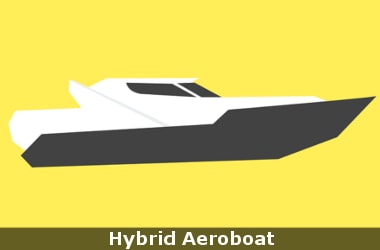
The world’s first hybrid aeroboat was put through its paces on the waters of the Pirogovsky Yacht Club, near Moscow, on 19th July 2017.
The vessel designed and built by IIAAT Holding, a joint venture between Russia’s International Institute for Advanced Aerospace Technologies and Indian firm Millennium Aerodynamics, with the support of the Skolkovo Foundation, can traverse water, land, ice, sand and swampland.
Five such aeroboats will be used in India for search and rescue operations.
The world’s first hybrid “aeroboat” capable of travelling on land, water, snow and sand that has been built by an Indo-Russian joint venture was thus unveiled in Moscow at a start-ups event organised by Russia’s state-run Skolkovo Foundation.
The aeroboat is designed to access difficult terrain, such as flooded or marshy areas where the use of regular boats is made impossible because of shallow water, patches of dry land or by marine vegetation.
It has been designed by IIAAT Holding, a joint venture between the International Institute for Advanced Aerospace Technologies and Indian firm Millennium Aerodynamics.
The aeroboat is on demonstration in and around a pond in the two-day Startup Village annual event in Moscow for technology entrepreneurs and investors organised by Russia’s biggest innovation fund the Skolkovo Foundation.
These are much faster and more robust than the comparable hovercrafts.
While hovercrafts on average move at around 45-50 km per hour on water, aeroboats are capable of going at around 150 km or more, he said.
The Aeroboat is also more robust than hovercrafts, and with estimated maintenance costs of $400-$600 per year, is cheaper to maintain and fuel.
It runs on a “hybrid” engine, meaning it can run on either petrol or electricity, enabling users to reduce carbon emissions and increase energy efficiency.
The aeroboats will be equipped with IoT (Internet of Things) technology, which allow remotely monitoring and controlling and diagnosing the equipment, as well as the ability to troubleshoot select faults.
According to the makers, with room for 10 passengers and one crew member, the 6.5-metre-long aeroboat can handle steep slopes and embankments, and does not require any marine infrastructure such as jetties, since it is amphibious.
Hovercrafts work on static air-cushion, whereas aeroboats work on dynamic air-cushion. This feature gives aeroboats a huge advantage in terms of speed and manoeuvrability,.
It’s possible to use hovercrafts, but they are very expensive to operate and also have speed limitations.
The amphibious aeroboats can provide high-speed year-round navigation, even when bodies of water are frozen like in Russia.